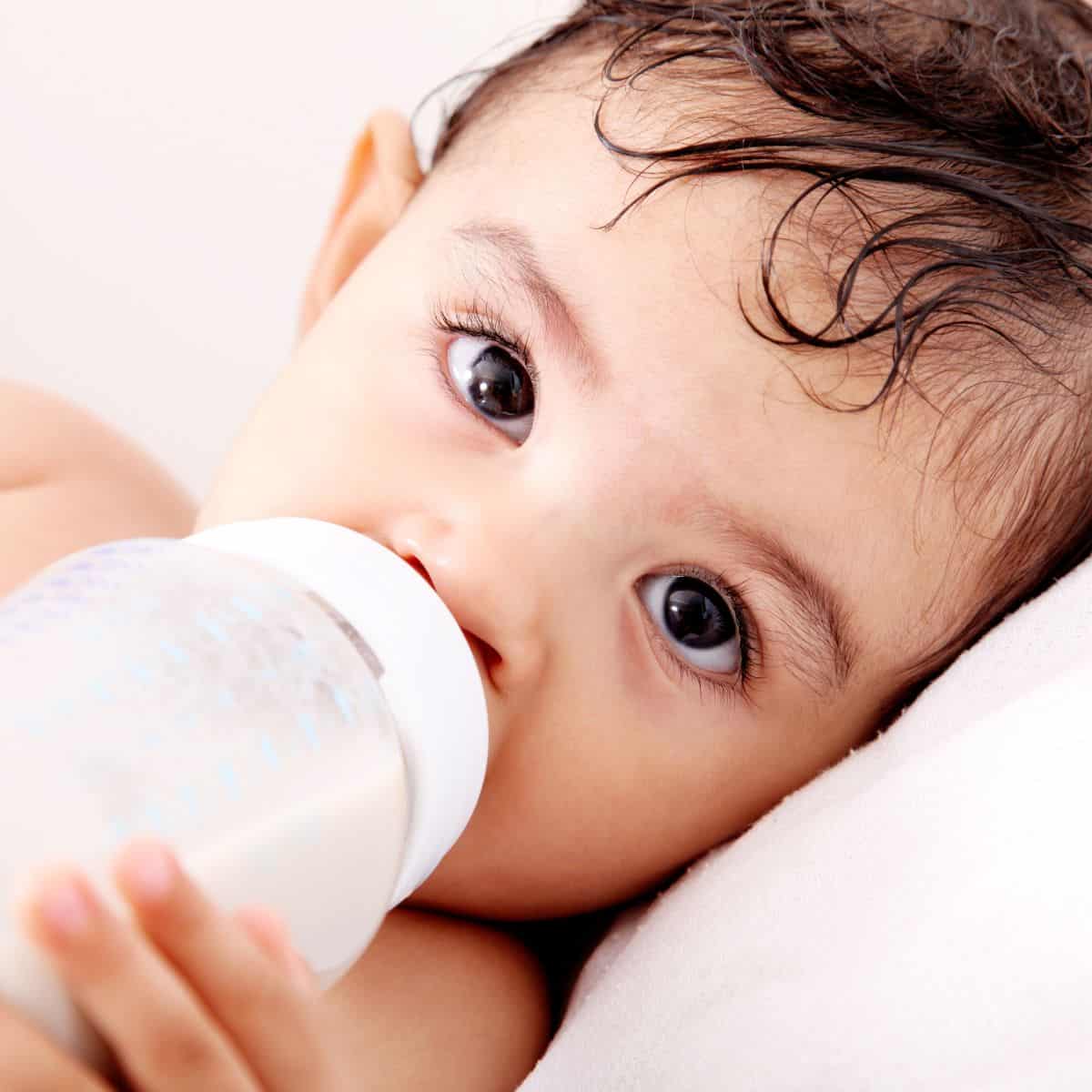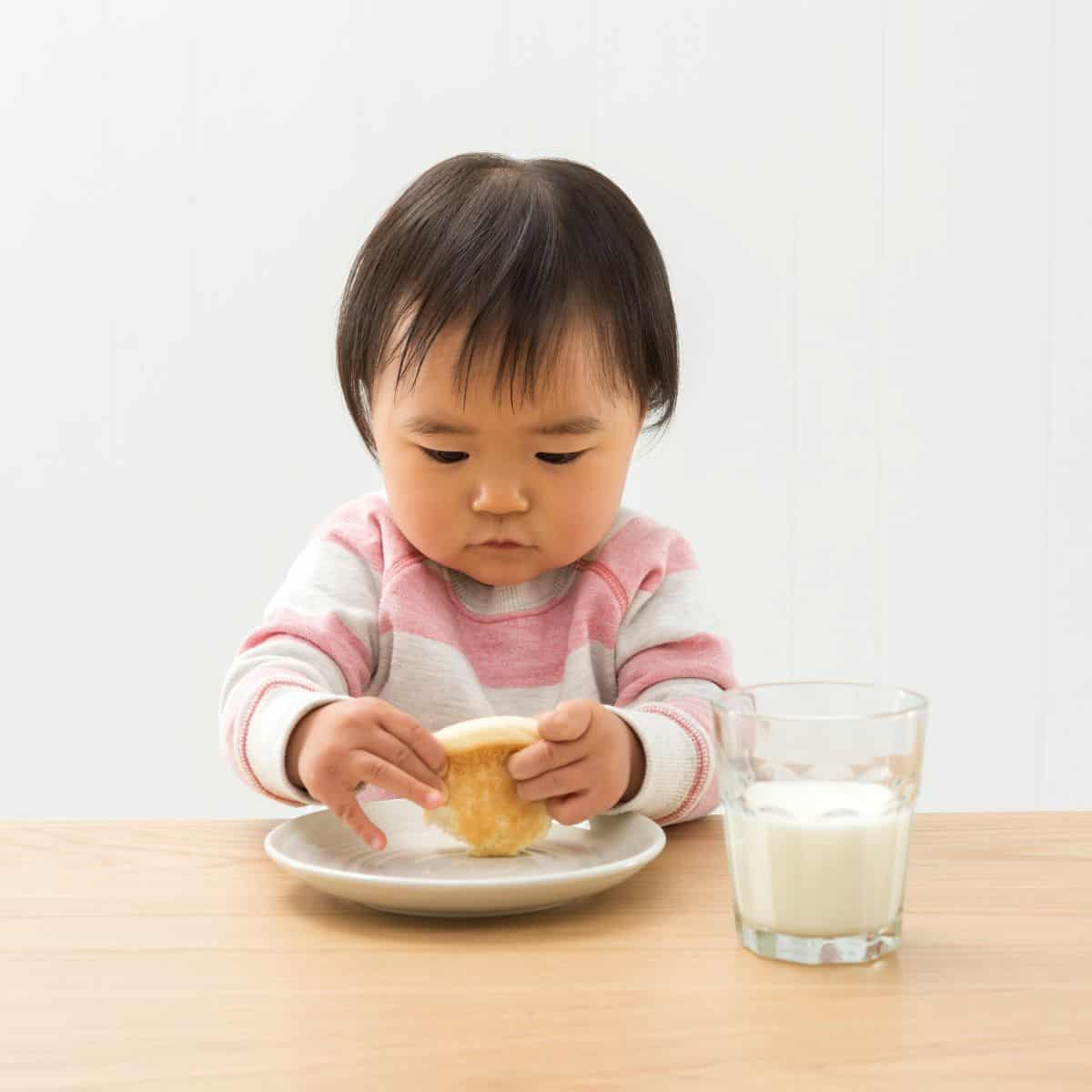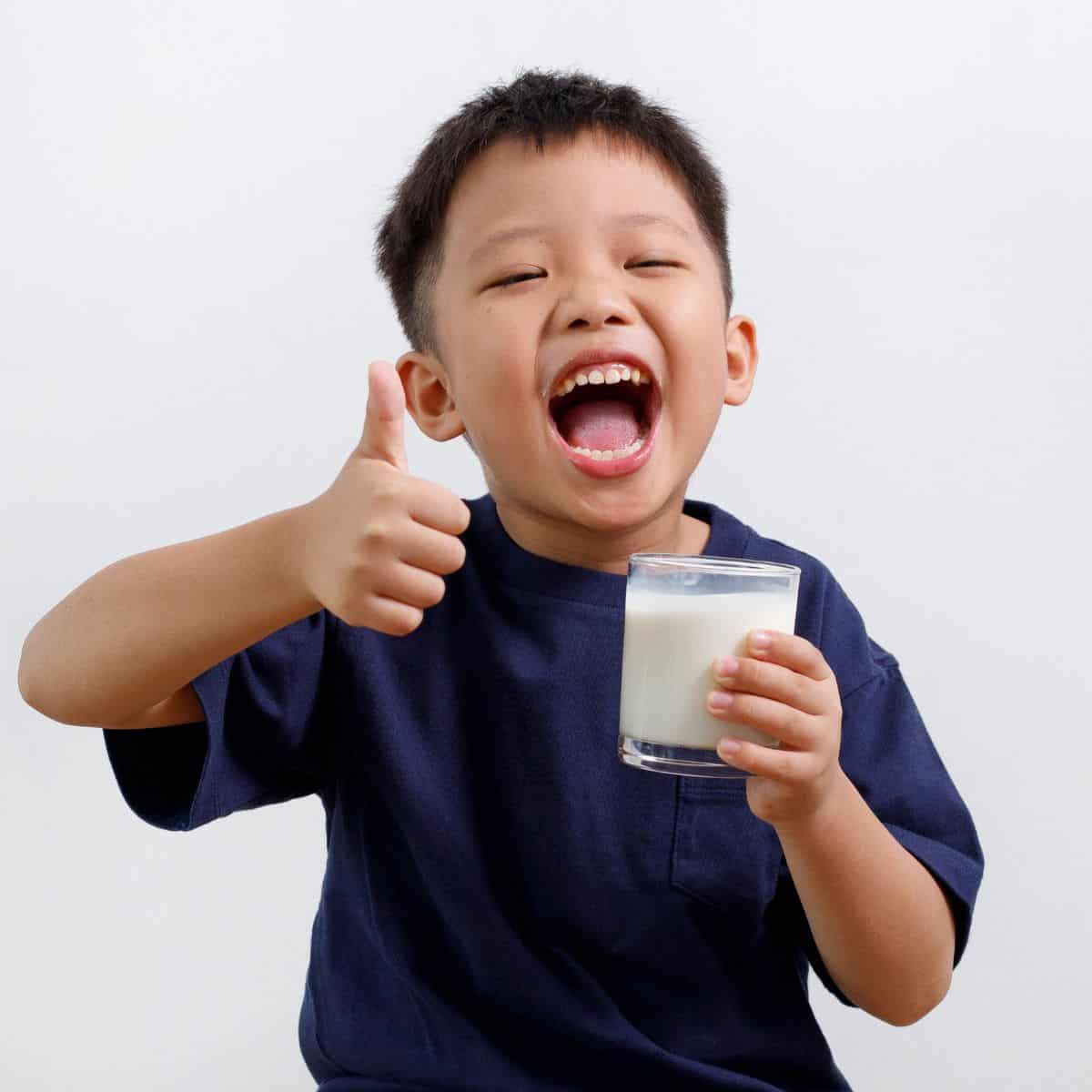All they want is milk! What to do and how to help if your toddler refuses to eat anything but milk
May 17, 2023, Updated May 05, 2025
This post contains affiliate links. Please see our disclosure policy.
Who knew that turning one came with a built-in milk obsession?!
Okay, maybe not built in…but it’s super common for toddlers to LOOOVE it!
If your toddler has an affinity for milk, it’s not a totally bad thing. I mean, milk provides tons of nutrients like protein, fat, vitamin D, calcium, and a bunch of vitamins and minerals.
(Power outlets…the cat’s tail…climbing up their dresser—there are worse things for toddlers to be drawn to!)
But if they’re constantly asking for milk, filling up on it, and choosing milk over other nutritious foods (or really any food), then it’s a habit I do recommend you gently help them break.
In this post, I’ll share how much milk I recommend toddlers have, then give you some strategies for keeping your toddler’s milk consumption within those guidelines. If your child is living a dairy-forward lifestyle right now, it’s one you’ll want to bookmark!

Table of Contents
- Why some toddlers seem to only want milk
- The right amount of milk for a toddler
- The effects of too much dairy
- #1 Too much dairy can crowd out other nutrients in the diet
- #2 Too much dairy can contribute to constipation and GI upset
- #3 Too much dairy can contribute to an iron deficiency
- How to help your toddler cut back on milk and dairy
- Toddler Milk FAQs
Why some toddlers seem to only want milk
Some toddlers can take or leave milk. Others want it first thing in the morning. With meals. Instead of meals. While watching TV. At bedtime. After bedtime. ALL the time!
If your child is like this, you might be wondering why. (Or whisper-screaming ‘WHYYY’ into the fridge.) I mean, it’s just milk, right? So why does it have such a strong hold on the toddlers of the Western world?
Well, rest assured that it’s nothing you did. Many toddlers have a strong preference for milk, and it’s simply because A) it tastes good and B) they associate it with comfort. (Your toddler might even associate it with you!)
Your toddler is so familiar with milk. Probably more so than any other food or drink! Whether it’s breastmilk or formula or cow’s milk, they’ve likely been drinking it throughout their life. They got it when they were sad, when they needed help sleeping, when they wanted comfort, and maybe even when they craved closeness with you. So milk isn’t just a way for your toddler to feel satisfied and full—it also comes with tons of positive emotional associations.
For toddlers who are picky eaters, milk can often feel like the safest way for them to get the calories their bodies are asking for when other foods seem scary. (Start here if you have a picky eater.)

So again, this milk “obsession” is not a horrible thing. It’s pretty logical and maybe even kinda sweet. (The “it reminds me of my parents” part, I mean!) It only becomes an issue if milk takes up too much of their diet. So, let’s define “too much.”
The right amount of milk for a toddler
I recommend that toddlers have a maximum 16-20 oz of milk per day, which works out to about 2 to 2.5 cups per day. And I recommend you spread that out over no more than 3 or 4 servings. That means you’d only offer milk OR other dairy products on 3-4 occasions throughout the day.
(To put that into context, 1 serving of dairy for a toddler would be ½ cup milk, ½ cup yogurt, or about 3/4 to 1 oz cheese. Also, a cheese stick is 1 oz.)

Let’s say your toddler is having 4 servings of milk a day (totaling about 2 cups). That’s fine in that it doesn’t exceed their max dairy for the day…but it also wouldn’t leave much room in their diet for other dairy products.
If they’re having 4 servings of milk and also having other dairy products like yogurt and cheese regularly, that’s where you may want to cut back a little bit.

The effects of too much dairy
There are 3 reasons why these are the dairy recommendations I always give for toddlers:
#1 Too much dairy can crowd out other nutrients in the diet
Milk has A LOT of good things going for it, but it also lacks a lot of things. Toddlers need balance and variety to meet their nutritional needs, and the best way for us to make sure they’re getting that is to feed them all different kinds of foods.
#2 Too much dairy can contribute to constipation and GI upset
It can be challenging for littles to digest dairy in large quantities, which can lead to upset tummies, toddler constipation (the worst!), and sometimes, a backed-up GI tract.
#3 Too much dairy can contribute to an iron deficiency
This happens in 2 ways:
- Dairy worsens the body’s ability to absorb iron (by a small amount).
- If toddlers fill up on dairy, they’re likely eating fewer iron-rich foods.
#2 is the main reason why iron deficiency tends to happen when drinking too much milk!
See Related: If Your Toddler Won’t Eat Meat (Toddler-Friendly Iron Sources)
How to help your toddler cut back on milk and dairy
Now that you know roughly how much dairy to aim for, let’s talk about ways to spread your toddler’s dairy consumption out across their days. So you can make sure they’re getting what they need from milk—but that they’re not drinking it so often that it crowds out other things.
Offer milk at mealtimes

This is a great strategy because, over time, it changes the way your toddler sees milk. What started as a comfort item will slowly become just another part of a balanced meal. I also love this strategy because your toddler’s body can better absorb the nutrients in milk when it’s paired with others foods. So it’s a nutritional and an emotional win.
Separate milk from bedtime
If you’re only offering milk at mealtimes, you’ll have this one down! But if not, try to slowly move milk up in your toddler’s bedtime routine, until it’s served early enough in the evening that it’s no longer part of bedtime at all. Then, once you’ve mastered that, move it back even further, so it’s just part of dinner. This is a great way to wean them, but it’s also helpful for preventing dental issues because milk right before bed can cause cavities.
Water it down
If you’re starting from a place where your child is drinking maaaany cups of milk each day, this is the tip I’d recommend. Because, yes, we ideally want to get them down to just a few servings of milk a day…but it’s hard to make a big change like this super quickly. Especially because milk can be a comfort item! (If this is resurfacing your pacifier-weaning trauma, I see you.)
My point is that I GET that you may not be able to just deny them the milk they’ve come to expect, cold turkey, right off the bat. And in that case, watering it down can be a great starting point. (But still try to work toward fewer servings when you and your toddler are mentally ready for that, k?)
Smaller portion sizes
When you do serve milk to your toddler, serve less than you did before. So if you’re used to filling their cup to the brim, try just ¾ full. This way, they’re still getting the milk they want and you don’t have to stop cold turkey, but you’ll inch your way closer to them consuming the optimal amount of dairy for their age.
Or, just opt for a smaller cup! Sometimes it’s not worth the battle when they want a FULL cup, so try something like this cup or this cup which will limit the serving size quite a bit.
Disclaimer: as an Amazon Associate I earn from qualifying purchases at no extra cost to you.
Say no sometimes
This is your friendly reminder that it is okay to limit milk or even say no sometimes. If, for example, your toddler wants milk in place of a snack, it would be okay for you to say something like:
“Today for a snack, we’re having X or Y.”
Or…
“Milk isn’t on the menu for snack time today, is there something else we could pick together that sounds good?”
Just mentally prepare to deal with the possible meltdown! And remember, we can’t always prevent them from getting upset. But I know it’s sometimes just hard to manage everything.

Toddler Milk FAQs
There’s a ton more I could say about milk…and for the most part, I’ve said it before! In this section, I’ll answer common questions rapid-fire and direct you to Mama Knows resources with more info where I can!
What’s the MINIMUM amount of milk my toddler needs?
This might surprise you, but…your child doesn’t need any amount of milk at all! So if they don’t like it, you don’t serve it, or you’re raising your child vegan, that’s okay. There are ways to get all the nutrients they would get from milk through other foods. You will just need to be a bit more mindful of things like vitamin D and calcium.
I love these vitamin D drops that you are probably familiar with from when they were a baby if you breastfed. But it’s actually recommended to continue providing vitamin D even past the baby stage! And if they are not regularly drinking vitamin D fortified milk, there’s a good chance they are not getting enough. (If they take a multivitamin, they might be getting it there.)

What type of milk is best?
If you’re looking for dairy, I always recommend whole milk until age 2. After age 2, it’s all about personal preference so it may depend on your child. Whole milk is an easy way to get a little more fat into their diet, so if you have trouble getting them to eat enough calories or other healthy, high-fat foods, then it could provide a little boost. But lower-fat milk is okay, too. Just know that we don’t need to moderate fat intake from whole foods for kids. It’s the opposite—healthy fat is a super helpful macronutrient for growing brains and bodies!
What about non-dairy milk?
Non-dairy milk is totally okay! The American Academy of Pediatrics (AAP) recommends soy milk as the best alternative to cow’s milk (it has the most similar nutritional profile in regards to macro and micronutrients). You’ll just want to steer clear of added sugar. In this post about alternative milks, I share my favorite brands plus some tips on what to look for and avoid!
Cups or bottles for milk?
After they turn 1, you’ll want to switch from bottles to cups. It’s developmentally appropriate for toddlers to learn to drink from an open cup early on! (Speech therapists will back me up on this because learning to drink from an open cup also helps with language development and appropriate oral muscular use!)
Ideally, by 18 months old, your toddler will have been exposed to drinking from open cups. (If your toddler is already 18 months+ and that hasn’t happened, it’s okay, this video can help!)
Straw cups are great, too. You’ll just want to avoid sippy cups (especially the hard spout kind).
As far as my favorite cups for toddlers go, this post has a full round-up!
One last thing!
If you want more information on cow’s milk, non-dairy alternatives, or anything else we’ve talked about in this post, then definitely read this deep dive on milk for toddlers!















This was super helpful and felt like a safe space as it allowed me to understand my child’s needs and how to get him off of milk also assuring me what I am doing is not wrong but also giving me advice on how to do it better.